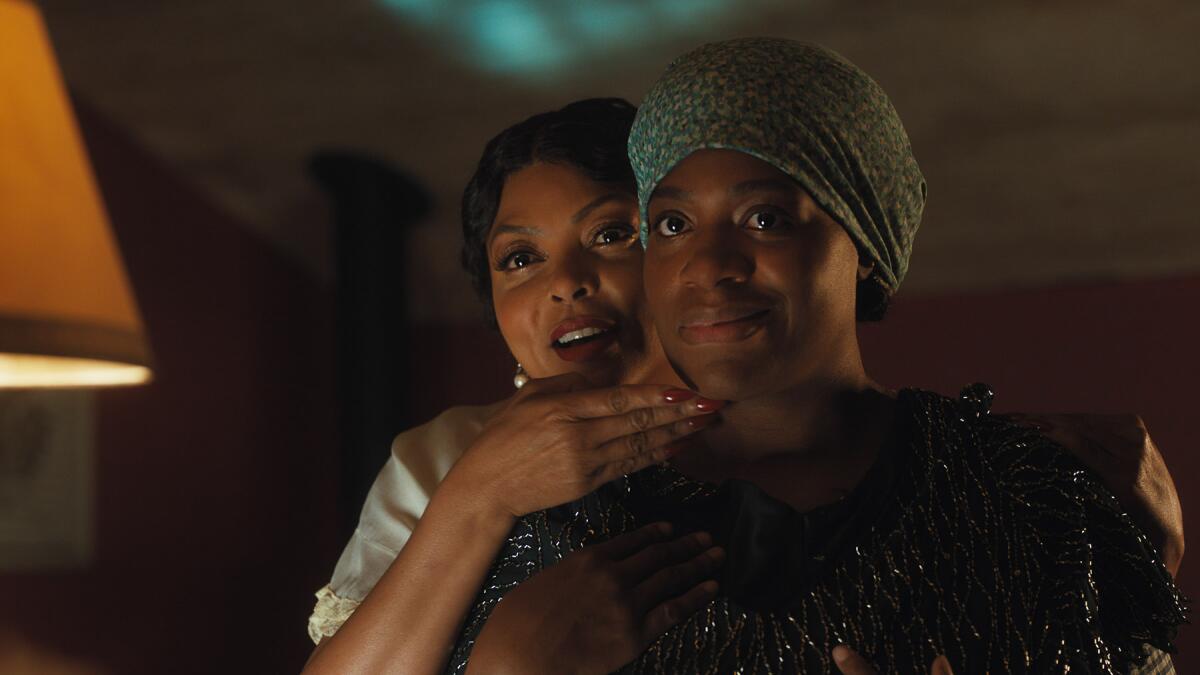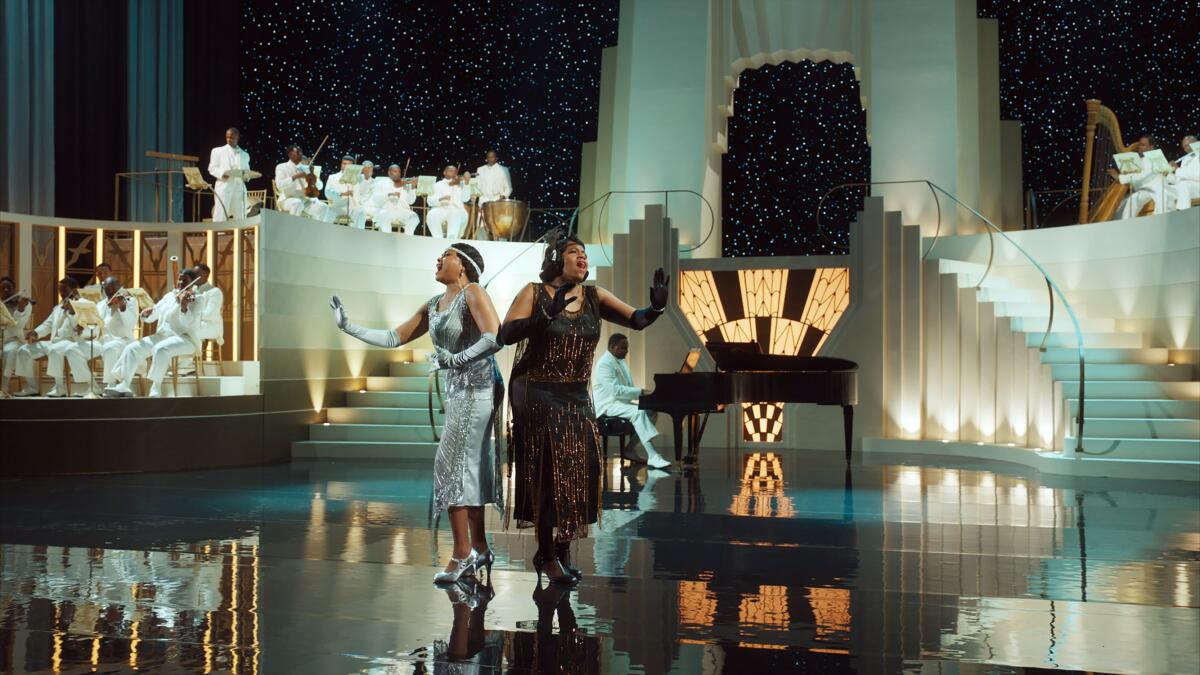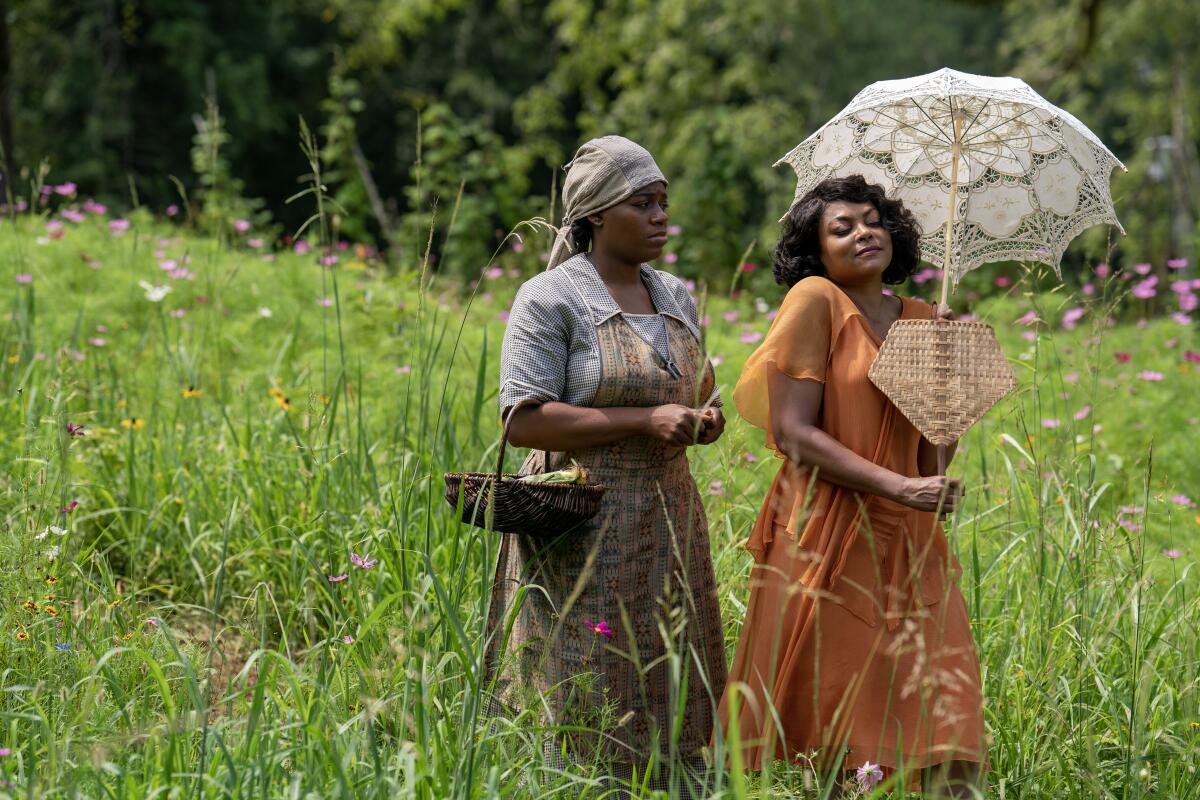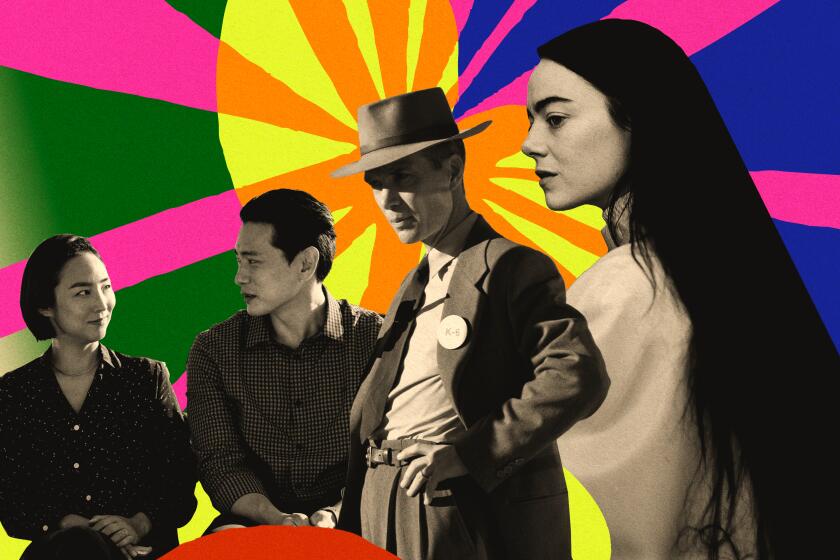The 40-year fight over ‘The Color Purple’s’ queer love story

- Share via
Warning: The following contains spoilers for “The Color Purple.”
Over the years, retellings of “The Color Purple” onscreen and onstage have explored many facets of Celie’s journey: horrific traumas at the hands of her father and husband; an unbreakable bond with her sister, Nettie; heroic triumphs over hardship.
But not every adaptation of Alice Walker’s Pulitzer Prize-winning novel has been so frank about Celie’s sexual orientation. And a new movie musical version of the story, in theaters Dec. 25, has reignited a decades-long debate over whether Hollywood and Broadway can ever do its most transformative romance justice.
The creators of the new movie are acutely aware of the criticism that past adaptations have downplayed the truth about the character’s sexuality. “Celie is a queer icon, and Alice Walker has been very vocal about that,” director Blitz Bazawule tell The Times. “Our job was to just lean into it harder, and give a little bit more context and a little more beauty to her coming-out moment.”
That moment occurs between Celie, a poor Black woman living in the rural South in the early 1900s, and Shug Avery, a free-spirited jazz-blues singer who is also the longtime mistress of Celie’s husband. The 1982 novel — which has been the subject of multiple book bans over the past 40 years for its depiction of homosexuality, among other controversial content — details Celie’s attraction to Shug from their first meeting, the sight of her naked body in the bath and the moment Shug remarks lovingly on Celie’s beauty and significance. Their intimate encounters are the only times Celie experiences sex that is caring and consensual, and their connection continues for years, even as Shug maintains relationships with other men and women.

Musician-turned-filmmaker Blitz Bazawule talks about transforming Alice Walker’s deeply moving book “The Color Purple” into an inventive musical that leans into Celie’s imagination.
Walker created Celie and Shug’s relationship in the novel because she “wanted to give my family and friends an opportunity to see women-loving women — lesbian, heterosexual, bi-sexual, ‘two-spirited’ — womanist women in a recognizable context. I wanted them, I suppose, to see me,” she wrote in her 1997 book “The Same River Twice: Honoring the Difficult.” More recently, Walker has elaborated on the real-life inspiration for Celie and Shug’s romance, spurred by an actor’s refusal to play Celie onstage.
“Celie ... is based on the life of my grandmother, Rachel, a kind and loving woman brutally abused by my grandfather,” Walker said in a statement in 2019. “It is safe to say, after a frightful life serving and obeying abusive men, who raped in place of ‘making love,’ my grandmother, like Celie, was not attracted to men. She was, in fact, very drawn to my grandfather’s lover, a beautiful woman who was kind to her, the only grown person who ever seemed to notice how remarkable and creative she was.
“In giving Celie the love of this woman, in every way love can be expressed, I was clear in my intention to demonstrate that she too, like all of us, deserved to be seen, appreciated, and deeply loved by someone who saw her as whole and worthy,” the statement continued. “Because I believe, and know, that sexual love can be extraordinarily holy, whoever might be engaging in it, I felt I had been able to return a blessing of love to a grandmother who had always offered only blessing and love, when I was a child, to me.”
In contrast with the book’s painstaking exploration of Celie’s pivotal romance with Shug, the women’s intimate relationship is relegated to a single brief scene in the 1985 film adaptation, which was directed by Steven Spielberg and earned 11 Oscar nominations. After hugging, dancing and laughing in a dressing room, Shug (Margaret Avery) tells Celie (Whoopi Goldberg) she’s beautiful and that she loves her, and then softly kisses her on her forehead, cheeks and lips.
Walker recalls in “The Same River Twice” that producer Quincy Jones received numerous letters from people “who adamantly opposed any display of sexual affection between Celie and Shug” and threatened to boycott the film. The scene’s very inclusion demanded “a bit of gentle insistence” on Walker’s part with Spielberg, Jones and screenwriter Menno Meyjes — and the final version, though it does depict a joyous, reciprocal encounter, lacks the sensuousness of Walker’s description in the novel.

“I knew the passion of Celie and Shug’s relationship would be sacrificed,” she adds, “when, on the day ‘the kiss’ was shot, Quincy reassured me that Steven had shot it ‘five or six’ different ways, all of them ‘tasteful.’”
Spielberg has since acknowledged the criticism that the scene is an insufficient depiction of the pair’s bond. “There were certain things in the [lesbian] relationship between Shug Avery and Celie that were finely detailed in Alice’s book that I didn’t feel could get a [PG-13] rating,” he said in a 2011 interview.
“And I was shy about it. In that sense, perhaps I was the wrong director to acquit some of the more sexually honest encounters between Shug and Celie, because I did soften those,” he continued. “I basically took something that was extremely erotic and very intentional, and I reduced it to a simple kiss.” (When asked if he would change it, he responded, “I wouldn’t, no. That kiss is consistent with the tonality, from beginning to end, of ‘The Color Purple’ that I adapted.”)
The shyness of Spielberg’s version is one reason why producer Scott Sanders pursued Walker in the late 1990s about creating a “Color Purple” stage musical. “She said, ‘The relationship between Celie and Shug is very important to me,’” he recalls. “I told her I would want to elaborate on that and really open it up. I said, ‘This is Broadway, we can touch on subjects like this, it’s not an issue.’”
Songwriters Brenda Russell, Allee Willis and Stephen Bray wrote songs representing the different stages of Celie and Shug’s courtship, including “What About Love?,” a romantic duet between two female characters that culminates in a kiss — still a rarity for a commercial musical.

The best movies of 2023 include ‘Oppenheimer,’ ‘Past Lives’ and ‘Poor Things,’ according to our critic Justin Chang.
From the start of the new movie musical project, Sanders, producer Oprah Winfrey and screenwriter Marcus Gardley sought to preserve, or even expand, the stage version’s treatment of the relationship.
“There’s a lot more intimacy between Celie and Shug in this movie than even was in the Broadway musical because we’re not on a proscenium stage anymore,” says Sanders. “It was important for us to make it abundantly clear to audiences that these two women had both a sexual relationship and a loving relationship, and that Celie had one love in this entire story.”
Director Bazawule underscores Celie’s attraction to Shug by “tracking the arc of how Celie finds what love is and who to love,” and making each representation of Celie’s romantic feelings “extravagant and memorable.” For instance, their “What About Love?” duet comes as the pair sneaks off to a date at a movie theater, which transforms into a sumptuous Art Deco concert stage.
“Celie’s mind goes into this incredible place of what she believes love is, and when she comes back into reality, it has happened to her,” Bazawule explains of the scene, which closes with a tender kiss in their theater seats. The next scene shows them waking up in the same bed after spending the night together.
“They probably didn’t even have the language for it that we use now, but they were courageous and found freedom in their love,” says Gardley. “One thing that’s important and vital about this story is that these women and their love for each other existed during this time period, and we really wanted to embrace and celebrate that.”

For a number of critics, this approach still falls short, not only of Walker’s original but even of other adaptations. As Autostraddle’s Carmen Phillips argues, for example, the movie musical sacrifices queer romance for a message of finding strength in sisterhood: “‘The Color Purple’ has never been only about Black women saving each other. It’s about Black women finding beauty and worth in each other, in all aspects of who we are, and on this Alice Walker could not be more clear: that means in our bedrooms, too.”
Of the potential for fresh backlash to the adaptation of Celie and Shug’s story, Sanders says, “There was nothing intentional to soften the relationship and, quite frankly, we thought we did a beautiful job with it. ... We show that they kissed, that they were romantic, that they slept together at least once. But how many scenes do you want to keep going back to the bedroom?”
Indeed, though the filmmakers have dropped or changed some material from the Broadway musical, they don’t view these choices as a form of erasure. The Act 2 argument that set up Celie’s showstopper “I’m Here” onstage, in which Shug leaves her for a young man, has been replaced by Celie’s discovery that her long-lost sister is alive — turning the number from a cry of heartbroken resentment into one of triumphant celebration, the creative team argues.
“It’s way more powerful,” says Gardley, who wrote the argument into the film script and only learned of the song’s new setup upon watching an early version of the movie. “And it feels like that’s what that moment should be about.”
For his part, Bazawule welcomes feedback from viewers, and he hopes future adaptations of Walker’s novel take it into consideration — just as he, Sanders and others have consistently looked to Spielberg’s adaptation to shape the story they wanted to tell.
“Who knows? Twenty, 30 years from now, another group might come and remake this again,” he says. “I don’t know what it will be then, but they will advance what queer representation looks like and all the things that we took upon ourselves to expand on. And it all gets to be part of the canon of ‘The Color Purple.’”

'The Color Purple'
Rating: PG-13
Running time: 2 hours, 20 minutes
Playing: In theaters Dec. 25
More to Read
Only good movies
Get the Indie Focus newsletter, Mark Olsen's weekly guide to the world of cinema.
You may occasionally receive promotional content from the Los Angeles Times.













